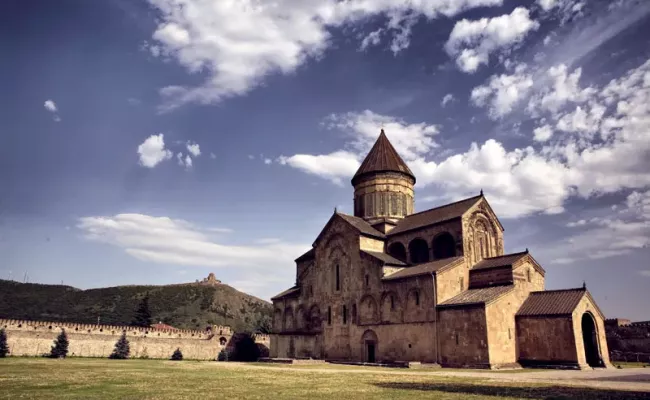Historic Monuments of Mtskheta
It has been a UNESCO World Heritage Site since 1994.
Mtskheta, located at the confluence of the Aragvi and Mtkvari Rivers in East Georgia, has historical significance due to cultural, economic, and political influences from the Roman and Persian Empires. Despite losing its capital status, Mtskheta is still a religious hub.
Built-in the sixth century on a rocky plateau on the opposite side of Mtskheta, Jvari Monastery demonstrates harmonious integration with the landscape and how buildings can coexist with nature.
Svetitskhoveli, one of the country’s largest cathedrals (11th century), is situated in the heart of Mtskheta. The 17th-century ciborium is believed to house the cloak of Christ, making it Georgia’s religious heart.
Another notable location is the 11th-century Samtavro Nunnery, built by Arsukisdze’s master. The western aedicule is the mausoleum of Miriani, the first Christian monarch of the Kartli Kingdom, and his wife Nana (4th century). The nunnery also has a 5th-century shrine dedicated to St. Nino, who was instrumental in spreading Christianity in the early fourth century.
Mtskheta’s medieval churches, including Jvari Monastery, Svetitskhoveli, and Samtavro Nunnery, reflect the Kartli Kingdom’s high level of art and culture. These monuments had significant political, religious, social, and economic implications for the region. They also represent the advent of Christianity in the Caucasus mountain region, providing superb examples of medieval church architecture and demonstrating changing building typologies from the fourth to the eighteenth centuries.
Integrity
The Historical Monuments of Mtskheta is a serial property that includes the Holy Cross Monastery of Jvari, Svetitskhoveli Cathedral, and Samtavro Monastery, all of which exhibit the evolution of the building typology from the fourth to the eighteenth century. The property’s components have kept their material integrity and key features, indicating Outstanding Universal Value. The influence of degradation processes is mitigated by continuing conservation and maintenance activities.
The monuments are significant markers in the cultural landscape of the Mtskheta River valley. The visual features of the environment are preserved through legislative and administrative actions as part of the management regime. However, defining the buffer zone remains an important step in improving property protection and providing a clear awareness of the archeological and visually sensitive regions surrounding the property. Potential hazards to the property’s setting resulting from development initiatives must also be mitigated through adequate land-use planning.
FAQ
How old is Sveticxoveli?
Vakhtang Gorgasali rebuilt Mirian’s church in the fifth century, and the current structure was built between 1010 and 1029 by Patriarch Melqisedek. Now a millennium old.
What is the oldest church in Mtskheta?
Antioch (IV-V centuries) – the Georgian Orthodox monastery and temple of St. Stephen the First Martyr in Mtskheta – is one of the oldest churches in Mtskheta .
How old is Mtskheta?
Archeological evidence trace human settlement in the area of Mtskheta from 2nd millennium BC to the early 1st millennium AD.
